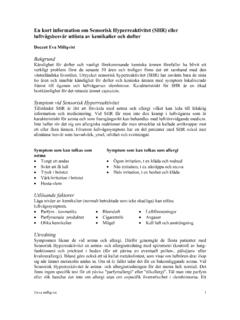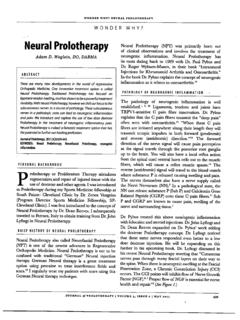Transcription of Determination of Capsaicin and Dihydrocapsaicin …
1 Determination of Capsaicin and Dihydrocapsaicin inCapsicumFruits by Liquid Chromatography Electrospray/Time-of-FlightMass SpectrometryANAGARCE S-CLAVER, MARI AS. ARNEDO-ANDRE S, JAVIERABADI A, RAMIROGIL-ORTEGA, ANDANAA LVAREZ-FERNA NDEZ*, Technology for Plant Production Department, Centro de Investigacio n y Tecnolog a Agroalimentaria(CITA), Apartado 727, E-50080 Zaragoza, Spain; and Plant Nutrition Department, Estacio nExperimental de Aula Dei, Consejo Superior de Investigaciones Cient ficas (CSIC), Apartado 202,E-50080 Zaragoza, SpainA simple, highly selective, sensitive, and reproducible liquid chromatography-electrospray ionization/time-of-flight mass spectrometry method has been developed for the direct and simultaneousdetermination of Capsaicin and Dihydrocapsaicin inCapsicumfruit extracts.
2 Capsaicin and dihydro- Capsaicin are the two major members of the so-called capsaicinoid family, which includes other minoranalogues, and usually account for at least 90% of the pungency trait separation of Capsaicin and Dihydrocapsaicin was achieved with a reversed-phasechromatography column, using a gradient of methanol and water. Quantification was done using asan internal standard (4,5-dimethoxybenzyl)-4-methyloctamide, a synthetic Capsaicin analogue notfound in nature. Analytes were base-peak resolved in less than 16 min, and limits of detection were20 pmol for Capsaicin and 4 pmol for Dihydrocapsaicin . The intraday repeatability values were lowerthan and 12% for retention time and peak area, respectively, whereas the interday repeatabilityvalues were lower than and 14% for retention time and peak area, respectively.
3 Analyte recoveriesfound were 86 and 93% for Capsaicin and Dihydrocapsaicin , respectively. The method developedhas been applied to the identification and quantification of Capsaicin and Dihydrocapsaicin in fruitextracts from differentCapsicumgenotypes, and concentrations found ranged from 2 to 6639 : Capsaicin ;Capsicum; Dihydrocapsaicin ; liquid chromatography; mass spectrometry;pepper; time-of-flightINTRODUCTIONF ruits of pepper (Capsicum) plants are among the mostconsumed spices throughout the world. These fruits containcapsaicinoids, a family of compounds that give them thecharacteristic pungent taste. The two major capsaicinoids, Capsaicin and Dihydrocapsaicin , are responsible for up to 90%of the total pungency of pepper fruits (1,2). Besides capsaicinand Dihydrocapsaicin , at least nine minor capsaicinoids (Figure1) have been shown to occur in peppers (3-7).
4 Capsaicinoidcompounds have been widely studied and are currently used inthe food industry, for medical purposes, as pharmaceuticals, andin defensive sprays (8-15).Capsaicinoids are alkaloids produced by a condensationreaction between an aromatic moiety and a C9-C11 branched-chain fatty acid. The aromatic moiety is vanillylamine, aphenylalanine derivative. Branched-chain fatty acids are bio-synthesized from valine and leucine, and in the case of capsaicinand Dihydrocapsaicin those acids differ in the degree ofunsaturation of the 9-carbon fatty acid side chain (1,16). Suzukiand Iwai (17) reviewed aspects related to the chemistry, analysis,biochemistry, and pharmacology of the pungency principle ofCapsicumspp. Further work on the chemistry and analysismethods for total and individual capsaicinoids has been reviewedby Govindarajan (18), Anu et al.
5 (19), and Pruthi (20).Capsaicinoids are synthesized exclusively in the epidermalcells of the placenta ofCapsicumfruits and are accumulated inblisters along the epidermis (21-23). Their biosynthesis beginsapproximately 20 days postanthesis (24), with a number ofenzymes being involved in the biosynthetic pathway. The degreeof pungency depends on theCapsicumspecies and cultivars,and the Capsaicin and Dihydrocapsaicin contents can be affectedby different factors such as the developmental stage of the fruit(25) and the environmental growth conditions (26-28). Forinstance, Kozukue et al. (29) reported values for Capsaicin and* Corresponding author (e-mail telephone+34976716052; fax+34976716145). Centro de Investigacio n y Tecnolog a Agroalimentaria (CITA). Consejo Superior de Investigaciones Cient ficas (CSIC).
6 J. Agric. Food ,54,9303 CCC: $ 2006 American Chemical SocietyPublished on Web 11/18/2006dihydrocapsaicin, respectively, ranging from a minimum of gg-1of fresh weight (FW) in canned sliced Jalapen o to maxima of 1187 and 771 gg-1of FW in Habanero freshpepper. The content of capsaicinoids in a given cultivar maydiffer by as much as 90 mg per fruit depending on environmentalfactors (30). Phenolic intermediates can influence the biosyn-thesis of capsaicinoids (31), and, for instance, it has beendemonstrated that 8-methylnonenoic acid could have an im-portant regulatory role in the capsaicinoid biosynthesis pathway(32).The first method developed to assess the pungency of fruitswas the Scoville organoleptic test (33), which estimatespungency (total capsaicinoid concentration) from the burningmouth sensation, using diluted samples and a tasting panel offive individuals.
7 This test is subjective and does not permit thedetermination of the levels of individual capsaicinoids. Subse-quently, capsaicinoids have been analyzed using spectropho-tometry (34-37) and near-infrared reflectance spectroscopy(NIR) (38,39). Techniques used to separate capsaicinoidsinclude paper chromatography (40), capillary gas chromatog-raphy (41,42), and especially high-performance liquid chro-matography (HPLC). The latter technique has been oftencoupled to UV-vis spectroscopy (43-53). Although HPLC-UV methods have been used successfully, they have limitedselectivity and most recent methods for the Determination of capsaici-noids have used HPLC coupled to more selective techniquessuch as mass spectrometry (29,54-56). Mass spectrometry hadalready been used to determine capsaicinoids in the past usingoff-line monitoring of HPLC effluents (57), HPLC-MS (58),and field desorption (59).
8 In the past decade, capsaicinoidanalytical techniques have been developed by using ionizationtechniques that permit HPLC-MS coupling, such as atmosphericpressure chemical ionization (APCI) (56,60) and electrospray(ESI) interfaces (29,61), using ion-trap or quadrupole massspectrometers. The high selectivity of HPLC-MS techniquescould possibly be applied to determine directly the concentra-tions of minor capsaicinoids in pepper fruits. Methods have beendeveloped for different matrices, such as self-defense materials(61),Capsicumoleoresin (62), and capsaicinoid-exposed blood(61). As far as we are aware, no reports on the determinationof capsaicinoids inCapsicumfruits have been developed usingtime-of-flight MS [MS(TOF)], a technique that allows thedetermination of exact mass and is capable of isotopic resolutionin the whole mass range without compromising sensitivity (63).
9 This study was aimed to develop and validate a selective andsensitive HPLC-ESI/MS(TOF) analytical method, allowing theidentification and accurate quantification of Capsaicin anddihydrocapsaicin, the two major capsaicinoids inCapsicumfruits. The method would be particularly suitable to routinelyanalyze capsaicinoids in breeding programs and may be usedto determine the concentrations of other minor capsaicinoidsonce appropriate standards are AND METHODSC hemical and eluents, buffers, and standard solutionswere prepared with analytical grade type I water (Milli-Q Synthesis,Millipore, Bedford, MA). Capsaicin (8-methyl-N-vanillyl-trans-6-nonenamide) (g97%), Dihydrocapsaicin (8-methyl-N-vanillylnonamide)(g90%), formic acid (50%), methanol ( , LC-MS grade),acetonitrile (LC-MS grade), 2-propanol (LC-MS grade), lithiumhydroxide monohydrate ( ), methionine (99%), and leucineenkephalin (Tyr-Gly-Gly-Phe-Leu, 98%) were purchased from Sigma-Aldrich (St.)
10 Louis, MO). The Capsaicin analogue (4,5-dimethoxyben-zyl)-4-methyloctamide (DMBMO) was synthesized according to themethod of Cooper et al. (62) and used as an internal standard. Theidentity of DMBMO was confirmed by nuclear magnetic resonance(NMR) spectrometry, and its purity was>98%. Labeled KNO3(10%15N) and NH4NO3(5%15N) were purchased from Cambridge IsotopesLaboratory (Andover, MA). CuSO2 5H2O and Fe(III)-EDTA werepurchased from Merck (Darmstadt, Germany), and NH4NO3and Na2-Figure structures and molecular weight ( ) of capsai-cinoids and Agric. Food Chem.,Vol. 54, No. 25, 2006 Garce s-Claver et 2H2O were purchased from Sigma-Aldrich. KNO3,KH2PO4, Ca-(NO3)2 4H2O, MnCl2 4H2O, H3BO3, and ZnSO4 7H2O were purchasedfrom Panreac Qu mica (Barcelona, Spain).





